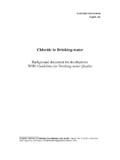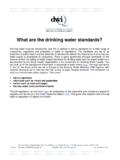Transcription of Chapter 6.9 Mercury - WHO/Europe
1 Chapter Mercury General description Mercury exists in three oxidation states: Hg (metallic), Hg+ (mercurous) and Hg++ (mercuric) Mercury . The latter forms a variety of inorganic as well as organometallic compounds. In the case of organometallic derivatives, the Mercury atom is covalently bound to one or two carbon atoms. In its elemental form, Mercury is a dense, silvery-white, shiny metal, which is liquid at room temperature and boils at 357 C. At 20 C, the vapour pressure of the metal is Pa ( mm Hg), and a saturated atmosphere at this temperature contains 14 mg/m3. Mercury compounds differ greatly in solubility; at 25 C, the solubilities of metallic Mercury , mercurous chloride and mercuric chloride in water are 60, 2 and 69 g/litre, respectively (1).
2 Sources Mercury is emitted to the atmosphere by natural degassing of the earth s surface and by re-evaporation of Mercury vapour previously deposited on the earth s surface. Mercury is emitted in the form of elemental vapour (Hg ). Annual natural emissions are estimated to be between 2700 and 6000 tonnes (2), some of which originate from previous anthropogenic activity. Anthropogenic sources of Mercury are numerous and worldwide. Mercury is produced by the mining and smelting of cinnabar ore. It is used in chloralkali plants (producing chlorine and sodium hydroxide), in paints as preservatives or pigments, in electrical switching equipment and batteries, in measuring and control equipment (thermometers, medical equipment), in Mercury vacuum apparatus, as a catalyst in chemical processes, in Mercury quartz and luminescent lamps, in the production and use of high explosives using Mercury fulminate, in copper and silver amalgams in tooth-filling materials, and as fungicides in agriculture (especially as seed dressings).
3 The Almaden Mercury mine in Spain, which accounts for 90% of the total output of the European Union, produces more than 1000 tonnes per year (3), but the amount of Mercury released to the environment is unknown. In total, human activities have been estimated to add 2000 3000 tonnes to the total annual release of Mercury to the global environment (2,4). However, it should be stressed that there are considerable uncertainties in the estimated fluxes of Mercury in the environment and in its speciation. The global cycle of Mercury involves the emission of Hg from land and water surfaces to the atmosphere, transport of Hg in the atmosphere on a global scale, possible conversion to unidentified soluble species, and return to land and water by various depositional processes.
4 The ultimate deposition of Mercury , probably as cinnabar ore, is believed to be in ocean sediments. Part of the inorganic Mercury emitted becomes oxidized to Hg++ and then methylated or in other ways transformed into organomercurials. The methylation is believed to involve a non-enzymatic reaction between Hg++ and a methylcobalamine compound (an analogue of vitamin B12) that is produced by bacteria (5). This reaction takes place primarily in aquatic systems. The intestinal bacteria flora of various animal species, including fish, are also able to convert ionic Mercury into methylmercuric compounds (CH3Hg+), although to a much lower degree (6). Methylmercury is avidly accumulated by fish and marine mammals and attains its highest concentrations in large predatory species at the top of the aquatic food-chain.
5 By this means, it enters the human diet. Certain microorganisms can demethylate CH3Hg+; others can reduce Chapter Mercury Air Quality Guidelines - Second Edition WHO Regional Office for Europe, Copenhagen, Denmark, 2000 2 Hg++ to Hg . Thus, microorganisms are believed to play an important role in the fate of Mercury in the environment and hence human exposure. Occurrence in air This topic has been reviewed by Lindqvist et al. (7). Background Mercury levels in the troposphere of the northern hemisphere are now estimated at 2 ng/m3. Levels in the upper troposphere are only slightly lower, but few measurements have been reported. In areas of Europe remote from industrial activity, such as rural parts of southern Sweden and Italy, mean concentrations of total Mercury in the atmosphere are reported to be usually in the range 2 3 ng/m3 in summer and 3 4 ng/m3 in winter.
6 Mean Mercury concentrations in urban air are usually higher; for example, a value of 10 ng/m3 has been reported in Mainz, Germany, and in an urban area of Italy. Individual determinations may cover a wide range of values. In the same urban area of Italy, the range was 2 3 ng/m3. Within the European Union, the following ranges for atmospheric Mercury have been documented: remote areas 6 ng/m3, urban areas 5 ng/m3 and industrial areas 20 ng/m3 (8). Hot spots of Mercury concentration have been reported in the atmosphere close to industrial emissions or above areas where Mercury fungicides have been used extensively. Fujimura (9) reported air levels of up to 10 000 ng/m3 near rice fields where Mercury fungicides had been used and values of up to 18 000 ng/m3 near a busy motorway in Japan.
7 Air values may rise to 600 and 1500 ng/m3 near Mercury mines and refineries (10). Few data are available on the speciation of Mercury in the atmosphere. However, it is generally assumed that metallic Mercury vapour is the predominant form (7,10,11). Johnson & Braman (12) reported the presence of organomercury compounds in the atmosphere above a highly polluted ocean bay in Florida, United States of America) and in a metropolitan area (Tampa, FL). In the latter, Mercury vapour accounted for 50%, mercuric halide vapour and monomethylmercury for 25% and 21% respectively, and dimethylmercury for only 1% of total gaseous Mercury . The water-soluble fraction is, on average, 5 10% of the total gaseous Mercury (7).
8 All published studies to date indicate that particulate Mercury accounts for less than 5% of total Mercury in the atmosphere. Total Mercury , assumed to be mainly metallic Mercury vapour, has a residence time of 3 years and is therefore globally distributed (7). The water-soluble form may have a residence time of only a few weeks. This water-soluble form and particulate Mercury , which also has a short residence time, although accounting for only a small fraction of total Mercury , may nevertheless be important in transport and depositional processes. Furthermore, the possibility that some conversion of water-insoluble to water-soluble forms of Mercury takes place in the atmosphere has been raised.
9 No data are available on indoor air pollution due to Mercury vapour. Fatalities and severe poisonings have resulted from heating metallic Mercury and Mercury -containing objects in the home. Incubators used to house premature infants have been found to contain Mercury vapour at levels approaching occupational threshold limit values; the source was Mercury droplets from broken Mercury thermostats. The exposure to Mercury vapour released from latex paint containing Mercury compounds to prolong shelf-life, can reach levels of 300 1500 ng/m3 (13). Indoor air pollution caused by central-heating thermostats and by the use of vacuum cleaners following thermometer breakage, etc.
10 , should also be considered. Chapter Mercury Air Quality Guidelines - Second Edition WHO Regional Office for Europe, Copenhagen, Denmark, 2000 3 Release of Mercury from amalgam fillings has been reviewed by Clarkson et al. (14). They concluded that amalgam surfaces release Mercury vapour into the mouth, and that this is the predominant source of human exposure to inorganic Mercury in the general population. Routes of exposure Air The only two sources of human exposure to metallic Mercury vapour are the general atmosphere and dental fillings. In adults, the daily amount absorbed into the bloodstream from the atmosphere as a result of respiratory exposure is about 32 ng in rural areas and about 160 ng in urban areas, assuming rural concentrations of 2 ng/m3 and urban concentrations of 10 ng/m3 (absorption rate 80%).

















